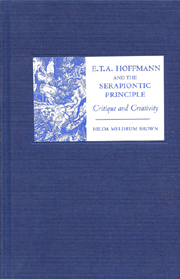Book contents
- Frontmatter
- Contents
- List of Illustrations
- Preface
- Acknowledgments
- List of Abbreviations
- Introduction: Approaches to the Serapiontic Principle
- Part 1
- 1 Overture: Jacques Callot
- 2 Der Einsiedler Serapion: The Formulation of a Principle
- 3 Der Dichter und der Komponist: Text and Music
- 4 Alte und neue Kirchenmusik
- 5 Prinzessin Brambilla: Callot Revisited
- 6 Epilogue: Des Vetters Eckfenster
- Part 2
- Conclusion
- Select Bibliography
- Index
3 - Der Dichter und der Komponist: Text and Music
from Part 1
Published online by Cambridge University Press: 05 February 2013
- Frontmatter
- Contents
- List of Illustrations
- Preface
- Acknowledgments
- List of Abbreviations
- Introduction: Approaches to the Serapiontic Principle
- Part 1
- 1 Overture: Jacques Callot
- 2 Der Einsiedler Serapion: The Formulation of a Principle
- 3 Der Dichter und der Komponist: Text and Music
- 4 Alte und neue Kirchenmusik
- 5 Prinzessin Brambilla: Callot Revisited
- 6 Epilogue: Des Vetters Eckfenster
- Part 2
- Conclusion
- Select Bibliography
- Index
Summary
As the title suggests, this dialogue addresses the relationship between words and music — here the libretto and the operatic score. It is an important historical landmark in the succession of lively debates over the centuries on this topic that have accompanied and tracked the emergence of German opera as a major and distinctive form, though Hoffmann's contribution has been somewhat neglected in comparison with those of other illustrious practitioners, who include Gluck, Carl Maria von Weber, Richard Wagner, Richard Strauss, and Hugo von Hofmannsthal. It was in fact an issue that so preoccupied Hoffmann that he had been planning to write an essay on the topic from as early as his Bamberg period (1809), when he was regularly producing and conducting operas at the theater. Hoffmann's perspective is polemical in that he is aware at the beginning of the nineteenth century of signs of degeneration in the form of opera in Germany (in his words, “die ausgeartete Form der Oper”) and is anxious to diagnose the causes, which, he suspects, may have something to do with the quality of libretti and the treatment of words by the composer; such a diagnosis may, hopefully, lead to a cure. In all this we detect something of Hoffmann's role as the pioneer figure in the evolution of German Romantic opera. In both versions of the essay (the earlier one of which appeared in the Allgemeine Musikalische Zeitung, the later one in Die Serapionsbrüder), Hoffmann's contribution is presented fictitiously through dialogue form but this dialogue in turn is placed within a complex frame in which different views are expressed.
- Type
- Chapter
- Information
- E. T. A. Hoffmann and the Serapiontic PrincipleCritique and Creativity, pp. 57 - 71Publisher: Boydell & BrewerPrint publication year: 2006

